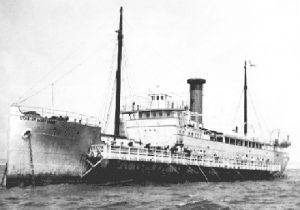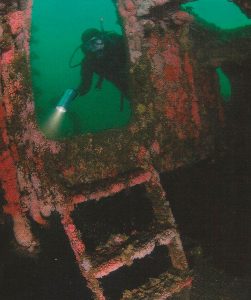Fallen ‘Star’ Had Galaxy of Troubles

Star of Scotland
The “Star” fell in Santa Monica Bay on January 23, 1942. Actually, she didn’t really fall…she sank, a victim of wear and tear on the high seas. Unfortunately, a seaman died when the 262-foot-long vessel rolled over in stormy waters that swept through the bay. The Star of Scotland was gone, but by no means forgotten.
How could anyone forget a ship that housed a gambling casino, promoted prostitution and was the scene of a notorious murder? Yet, these devious deeds were somewhat overshadowed by heroism in WWI when she sank a German submarine shortly after being commissioned into the British Royal Navy as the HMS Mistletoe. She was at that time one of a unique fleet of warships built in 1918 to counter-attack the onslaught of German U-boats. Known as Q-ships, which were secretly built in Queenstown, Ireland, the 1,250-ton innovations were warships converted and disguised as merchantmen. Guns, depth charges and other weapons were hidden behind fake bulwarks, deck houses and cargo containers. Skilled navy gun crews were disguised as grizzly seamen conducting ordinary merchant duties until it was time to jump into action. Like something out of a Clive and Dirk Cussler novel, a fighting Q-ship could quickly change its entire appearance with the aid of canvas, wood, paint and funnels, all set up under cover of darkness.
In 1921, the Mistletoe–destined to sail under nine other names during her 25-year career—was sold to a Mexican shipping company. Now the Chiapas, she regained her original role as a merchantman transporting cargo between Panama and San Francisco. Sold within a few years and renamed La Playa de Ensenada, her specialty was fruit shipped from Mexico to major cities on the west coast of the U.S. The fruit was lucrative, but soon replaced by booze when the depression came along in 1929. That’s when a sleazy new owner cut the name back to La Playa and made it a floating speakeasy and gambling casino.

Diver Examines Collapsed Remains
Dr. Sam Miller and Pat Smith, two founding members of the California Wreck Divers Club, call the Star “the most prolific dive site in Santa Monica Bay.” Logging in hundreds of dives on it throughout the years, they’ve retrieved their share of fish, lobsters and artifacts from the original Q-ship that rests in 70 feet of water. It attracts sea bass in gaping holes throughout the remains that rise 15 to 20 feet from the bottom. Both Miller and Smith forewarn divers not to penetrate any openings. The decks collapsed when the hull plates separated and created fragile honeycombed chambers. Mackerel, bonito, halibut and lingcod are just a few of many species that frequent the wreck. Rock scallops, flanked by bright colored anemones, cling to twisted steel beams and catwalks. Visibility averages 10 feet, but increases considerably when the offshore winds of winter sweep across the bay. The Star remains, once subjugated by greed and salacious behavior, now recognized eminently as a wartime heroine and divers’ paradise.
Note: Shipwrecks of Southern California by Pat Smith and Bonnie Cardone (Menasha Ridge Press, Birmingham, Alabama, 1989) features a chapter on the Star of Scotland in addition to 50 other popular wreck sites.
8 Comments
Submit a Comment
All Rights Reserved © | National Underwater and Marine Agency
All Rights Reserved © | National Underwater and Marine Agency
Web Design by Floyd Dog Design
Web Design by Floyd Dog Design

Great Article, I’ve always loved reading the stories about the Q-Ships and other stealthy methods of commerce warfare during the Great War. Professor Boyd, if you ever get the chance check out “Into the Danger Zone”, Sea crossings of the first world war. By Tad Fitch & Michael Poirier.
What an interesting story about the Star of Scotland. It was like reading an adventure story: murder, gambling, prostitution, everything like you say… in an adventure novel. I will get a copy of the California Shipwrecks book you mentioned and read more about it. Thank you!
What an interesting history! You mentioned that it was a “Q” ship. Being a WWII buff, I would be interested in reading more about these clandestine vessels. Thank you.
Hi Captain Allen: Thank you for your kind words! Yes, I too am more interested in the Q-ships now. I will do more research on them and perhaps write something about them in the future. Thanks for the tip: I shall look up the book: “Into the danger Zone.”
Dear Julie: Thank you ! I’m so glad you liked my article about the Star of Scotland. Yes, you can get a copy of California Shipwrecks on Amazon. It has many other interesting stories about many different shipwrecks off the California coast and waterways leading to the Pacific.
Good stuff
do you or aanybody know any thing about finding bottles of wine on the wreck as I have found and was wondering where it might have came from
and yes its an amazing dive
The California Wreck Divers have founds lots of artifacts on the wreck. Email my friend, Dr. Sam Miller at:
[email protected]
He knows all about the wreck and what divers have discovered on it. Write me back at: [email protected] And let me know what he says. If you don’t hear from him, let me know and I will send you the email for another California Wreck Diver.
[email protected]